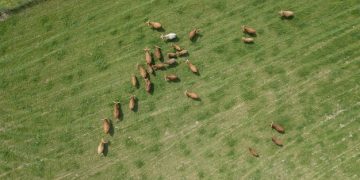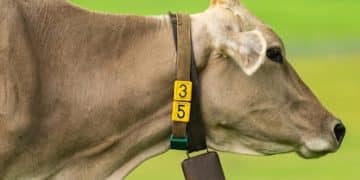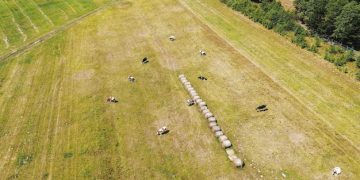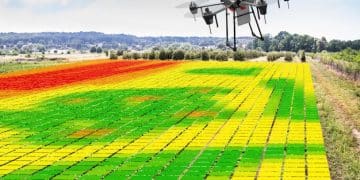Livestock Monitoring Technology: Preventing Disease and Reducing Losses in US Farms
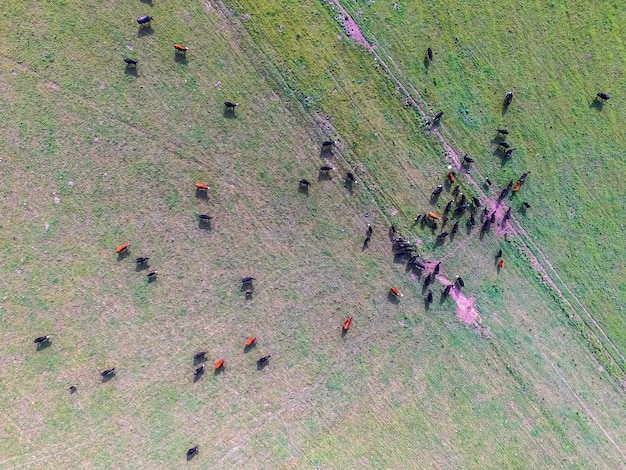
Livestock monitoring technology offers innovative solutions for preventing disease outbreaks and reducing economic losses by providing real-time data, enabling early detection and informed management decisions on farms across the US.
The application of technology in livestock management is rapidly transforming farming practices in the United States. Livestock monitoring technology is emerging as a critical tool for farmers aiming to enhance animal welfare, prevent disease outbreaks, and minimize economic losses.
The Rise of Livestock Monitoring Technology
Livestock monitoring technology is rapidly changing agricultural practices by providing real-time insights into animal health, behavior, and environmental conditions. This proactive approach allows farmers to detect potential problems early, preventing widespread disease and minimizing economic impacts.
What is Livestock Monitoring Technology?
Livestock monitoring technology encompasses a range of tools and systems designed to remotely observe and gather data on livestock. These technologies offer continuous, non-invasive monitoring to track vital signs, movement patterns, and other key indicators.
These innovative systems enable farmers to detect subtle changes in animal behavior or physiology that might indicate illness or stress. By leveraging these insights, producers can implement targeted interventions.
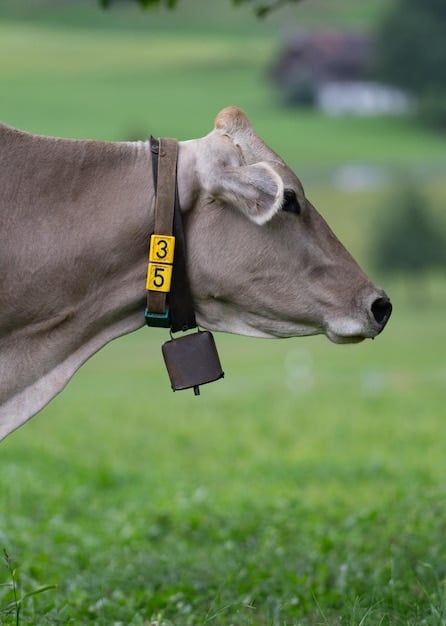
- Smart Sensors: Wearable devices attached to animals that monitor metrics like body temperature, heart rate, and activity levels.
- GPS Tracking: Systems that track the location of livestock, aiding in pasture management and preventing theft.
- Automated Feeding Systems: Technology that monitors feed consumption and adjusts delivery to optimize nutrition and reduce waste.
- Environmental Sensors: Devices that monitor temperature, humidity, and air quality within livestock housing to ensure optimal conditions.
The adoption of livestock monitoring technology enhances farm efficiency by automating routine tasks, improving resource allocation, and enabling data-driven decision-making. By continuously monitoring animal health and behavior, farmers can identify and address potential issues before they escalate.
Benefits of Livestock Monitoring Technology
The advantages of implementing livestock monitoring technology are extensive. From improving animal health to increasing overall farm efficiency, these technologies offer a wide array of benefits.
Early Disease Detection
One of the primary benefits of livestock monitoring technology is its ability to detect diseases early. By tracking vital signs and behavior patterns, farmers can identify anomalies that may indicate illness.
Early detection allows for prompt treatment, reducing the spread of disease and minimizing the number of animals affected.
Optimized Resource Management
Livestock monitoring technology enables better resource management by providing insights into feed consumption, water usage, and grazing patterns. This data can help farmers optimize their operations to reduce waste and improve efficiency.
For instance, automated feeding systems can adjust feed delivery based on individual animal needs, ensuring that each animal receives the right amount of nutrition. This targeted approach reduces feed waste and promotes healthier growth.
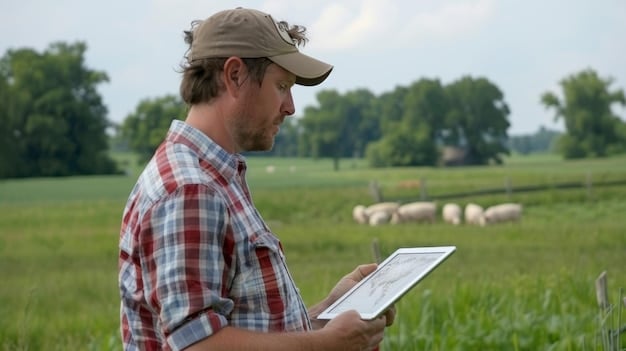
- Reduced Labor Costs: Automation reduces the need for manual monitoring, freeing up labor for other tasks.
- Improved Animal Welfare: Continuous monitoring ensures animals are healthy and comfortable, leading to better overall welfare.
- Enhanced Productivity: Healthier animals and optimized resource use result in increased productivity.
- Data-Driven Decisions: Real-time data allows farmers to make informed decisions based on accurate information.
By optimizing resource management and improving animal welfare, livestock monitoring technology helps to create more sustainable and efficient farming operations. This not only benefits the animals but also enhances the economic viability of the farm.
Types of Monitoring Technologies Available
A variety of livestock monitoring technologies are available, each designed to address specific needs and challenges in livestock management. These technologies range from wearable sensors to advanced imaging systems.
Wearable Sensors
Wearable sensors are devices attached to animals to monitor various health metrics and behavioral patterns. These sensors can track body temperature, heart rate, activity levels, and even rumination patterns.
The data collected by wearable sensors is transmitted wirelessly to a central system, allowing farmers to access real-time information about their livestock.
GPS Tracking Systems
GPS tracking systems use satellite technology to monitor the location of livestock. These systems are particularly useful for managing grazing patterns and preventing theft.
By tracking the movement of animals, farmers can optimize pasture use and ensure that livestock remain within designated areas.
Imaging Technologies
Imaging technologies, such as thermal cameras and drone-based systems, provide visual insights into livestock health. Thermal cameras can detect changes in body temperature that may indicate illness, while drones can provide aerial views of grazing patterns and overall herd health.
These technologies offer a non-invasive way to assess the condition of livestock and identify potential problems.
- Audio Monitoring: Microphones placed in livestock housing can detect coughs, sneezes, and other sounds indicative of respiratory illness.
- Smart Ear Tags: Ear tags equipped with sensors that monitor body temperature, heart rate, and other vital signs.
- Automated Sorting Systems: Systems that use sensors to automatically sort animals based on weight, health status, or other criteria.
The diverse range of monitoring technologies available allows farmers to choose solutions that best fit their specific needs and operational goals. Whether it’s tracking animal health, optimizing resource use, or enhancing pasture management, there is a technology to address virtually every aspect of livestock farming.
Implementing Livestock Monitoring Technology
Implementing livestock monitoring technology requires careful planning and consideration. Understanding the steps involved can help ensure a smooth and successful transition.
Assessing Your Needs
Before investing in livestock monitoring technology, it’s important to assess your specific needs and goals. Consider the types of livestock you manage, the challenges you face, and the outcomes you hope to achieve.
By clarifying your objectives, you can select technologies that are most relevant to your operation.
Choosing the Right Technology
Selecting the right technology involves researching different options and comparing their features and capabilities. Consider factors such as cost, ease of use, accuracy, and compatibility with existing systems.
It may also be helpful to consult with other farmers who have implemented livestock monitoring technology, or to seek advice from agricultural extension agents.
Training and Support
Proper training and ongoing support are essential for maximizing the benefits of livestock monitoring technology. Ensure that your staff is adequately trained to use the technology effectively, and that support is available to address any technical issues or questions that may arise.
Many technology providers offer training programs and ongoing support to help farmers get the most out of their systems.
- Start Small: Begin by implementing technology on a small scale to test its effectiveness and identify any potential challenges.
- Data Analysis: Ensure that you have the resources and expertise to analyze the data collected by the technology.
- Integration: Consider how the technology will integrate with your existing farm management systems.
By carefully planning and executing the implementation of livestock monitoring technology, farmers can realize significant improvements in animal health, resource management, and overall farm efficiency. Taking a strategic approach ensures that the investment yields valuable returns and contributes to the long-term sustainability of the operation.
Case Studies: Success Stories in the US
Several farms in the United States have successfully implemented livestock monitoring technology, achieving remarkable results. These case studies provide real-world examples of the benefits of these technologies.
Dairy Farm in Wisconsin
A dairy farm in Wisconsin implemented wearable sensors to monitor the health of its cows. The sensors tracked body temperature, activity levels, and rumination patterns, allowing the farmer to detect illnesses early.
As a result, the farm reduced its use of antibiotics by 30% and improved milk production by 10%.
Beef Cattle Ranch in Texas
A beef cattle ranch in Texas used GPS tracking systems to manage grazing patterns and prevent theft. The GPS system allowed the rancher to monitor the location of his cattle in real-time, ensuring they remained within designated grazing areas.
The rancher was able to optimize pasture use, reduce feed costs, and prevent cattle theft. By implementing such systems farmers are able to improve their overall livestock management.
Poultry Farm in Georgia
A poultry farm in Georgia installed environmental sensors to monitor temperature, humidity, and air quality within its chicken houses. The sensors provided real-time data on environmental conditions, allowing the farmer to make adjustments to maintain optimal conditions for the birds.
The farm reduced mortality rates by 15% and improved feed conversion ratios by 8%.
- Increased Efficiency: Farms that have implemented livestock monitoring technology have reported significant increases in efficiency.
- Reduced Costs: Livestock monitoring technology can help reduce costs by optimizing resource use and preventing disease outbreaks.
- Improved Sustainability: By improving animal health and optimizing resource use, livestock monitoring technology contributes to more sustainable farming practices.
These success stories highlight the potential of livestock monitoring technology to transform farming practices in the United States. By embracing these innovative tools, farmers can improve animal health, increase efficiency, and enhance the sustainability of their operations.
The Future of Livestock Monitoring
The field of livestock monitoring is continuously evolving, with new technologies and applications emerging all the time. The future of livestock monitoring promises even greater efficiency, accuracy, and integration.
Artificial Intelligence (AI)
AI is playing an increasingly important role in livestock monitoring. AI algorithms can analyze large datasets of animal health and behavior data to identify patterns and predict potential problems.
AI-powered systems can provide farmers with personalized recommendations for managing their livestock, optimizing resource use, and preventing disease outbreaks.
Internet of Things (IoT)
The Internet of Things (IoT) is connecting livestock monitoring devices to the internet, enabling seamless data sharing and remote access. IoT-enabled systems allow farmers to monitor their livestock from anywhere, at any time.
IoT technology also facilitates the integration of livestock monitoring data with other farm management systems, such as accounting software and weather forecasting tools.
Robotics
Robotics is being used to automate various tasks in livestock farming, such as feeding, milking, and cleaning. Robotic systems can perform these tasks more efficiently and accurately than humans, reducing labor costs and improving productivity.
Robots can also collect data on animal health and behavior, providing farmers with valuable insights.
- Improved Data Analytics: Advances in data analytics will enable farmers to extract even more insights from livestock monitoring data.
- Enhanced Connectivity: Improved connectivity will allow for seamless integration of livestock monitoring systems with other farm management tools.
- Greater Adoption: As the benefits of livestock monitoring technology become more widely recognized, adoption rates are expected to increase.
The future of livestock monitoring is bright, with exciting possibilities for improving animal health, enhancing efficiency, and promoting sustainability. By embracing these advancements, farmers can ensure that their operations are well-positioned for success in the years to come.
| Key Point | Brief Description |
|---|---|
| 🩺 Early Disease Detection | Identifies health issues early, reducing spread and impact of diseases. |
| 🌱 Optimized Resource Management | Improves efficiency in feed and water use, reducing waste. |
| 📍 GPS Tracking | Monitors livestock location, preventing theft and optimizing grazing. |
| 📊 Data-Driven Decisions | Enables informed decisions based on real-time data, improving farm management. |
Frequently Asked Questions
▼
Livestock monitoring technology involves the use of sensors, GPS, and imaging tools to remotely observe and gather data on livestock, enhancing animal health and farm efficiency.
▼
By continuously tracking vital signs and behavior patterns, livestock monitoring technology allows for early detection of anomalies that may indicate illness, helping prevent disease spread.
▼
Various include wearable sensors for body temperature, heart rate, activity levels, GPS trackers for location, and environmental sensors for conditions in livestock housing.
▼
GPS tracking helps manage grazing patterns, prevent theft, and ensure livestock stay within designated areas, optimizing pasture use and reducing operational costs.
▼
AI algorithms analyze animal health and behavior data to identify patterns and predict potential problems, providing personalized recommendations to manage livestock efficiently.
Conclusion
Livestock monitoring technology is revolutionizing farming practices in the United States by providing real-time data that supports early disease detection, optimized resource management, and improved overall animal welfare, leading to more sustainable and efficient operations.
